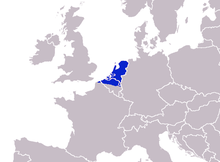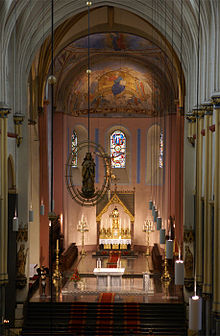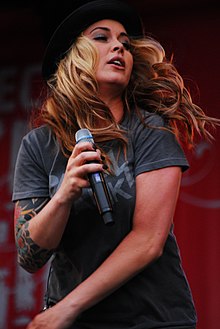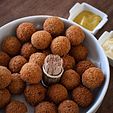Culture of the Netherlands

| Part of a series on the |
| Culture of the Netherlands |
|---|
 |
| History |
|
People |
| Languages |
|
Folklore |
| Cuisine |
| Festivals |
| Religion |
|
Art |
| Music |
| Sport |
The culture of the Netherlands is diverse, reflecting regional differences as well as the foreign influences built up by centuries of the Dutch people's mercantile and explorative spirit. The Netherlands and its people have long played an important role as centre of cultural liberalism and tolerance. The Dutch Golden Age is popularly regarded as its zenith.
Language

The
There is a tradition of learning foreign languages in the Netherlands: about 89% of the total population have a good knowledge of English, 70% of German, 29% of French and 5% of Spanish.
Religion


Religions in the Netherlands (2015)[2]
Between the Celtic and Germanic peoples and later the Roman conquerors a cultural exchange took place. An adaptation of polytheistic religions and each other's myths took place among the various tribes, coming from the Germanic, Celtic and later Roman mythology. From the 4th to the 6th century AD
Until late into the 20th century, the predominant religion in the Netherlands was Christianity. Although religious diversity remains, there has been a decline in religious adherence. In 2006, 34% of the Dutch population identified as Christian,
A large majority of the Dutch population believes that religion should not have a determining role to play in politics and education. Religion is also decreasingly seen as a social binder,
From a December 2014 survey by the VU University Amsterdam it was concluded that for the first time there are more atheists (25%) than theists (17%) in the Netherlands. The majority of the population being agnostic (31%) or ietsists (27%).[9] Atheism, agnosticism and Christian atheism are on the rise and are widely accepted and considered to be non-controversial. Among those who adhere to Christianity, there are high percentages of atheists, agnostics and ietsism, since affiliation with a Christian denomination is also used in a way of cultural identification in the different parts of the Netherlands.[10] In 2015, a vast majority of the inhabitants of the Netherlands (82%) said they had never or almost never visited a church, and 59% stated that they had never been to a church of any kind. Of all the people questioned, 24% saw themselves as atheist, which is an increase of 11% compared to the previous study done in 2006.[2] The expected rise of spirituality (ietsism) has come to a halt according to research in 2015. In 2006 40% of respondents considered themselves spiritual, in 2015 this has dropped to 31%. The number who believed in the existence of a higher power fell from 36% to 28% over the same period.[3]
Christianity is currently the largest religion in the Netherlands. The provinces of
Other religions account for some 6% of the Dutch people. Hinduism is a minority religion in the Netherlands, with around 215,000 adherents (slightly over 1% of the population). Most of these are Indo-Surinamese. There are also sizable populations of Hindu immigrants from India and Sri Lanka, and some Western adherents of Hinduism-oriented new religious movements such as Hare Krishnas. The Netherlands has an estimated 250,000 Buddhists or people strongly attracted to this religion, mainly ethnic Dutch people. There are about 45,000 Jews in the Netherlands.
Art and media
Art

Dutch painters, especially in the northern provinces, tried to evoke emotions in the spectator by letting him/her be a bystander to a scene of profound intimacy. Portrait painting thrived in the Netherlands in the 17th century. A great many portraits were commissioned by wealthy individuals. Group portraits similarly were often ordered by prominent members of a city's civilian guard, by boards of trustees and regents, and the like. Often group portraits were paid for by each portrayed person individually. The key example to this is The Night Watch by Rembrandt. The amount paid determined each person's place in the picture, either head to toe in full regalia in the foreground or face only in the back of the group. Sometimes all group members paid an equal sum, which was likely to lead to quarrels when some members gained a more prominent place in the picture than others. Allegories, in which painted objects conveyed symbolic meaning about the subject, were often applied. Many genre paintings, which seemingly only depicted everyday life, actually illustrated Dutch proverbs and sayings, or conveyed a moralistic message, the meaning of which is not always easy to decipher nowadays. Favourite topics in Dutch landscapes were the dunes along the western seacoast, rivers with their broad adjoining meadows where cattle grazed, often a silhouette of a city in the distance.

The
Architecture

The

During the 20th century Dutch architects played a leading role in the development of modern architecture. Out of the early 20th century rationalist architecture of
Literature

Some of the most important and internationally awarded writers are:
16th century:
- Desiderius Erasmus
17th century:
- Baruch de Spinoza
- Pieter Corneliszoon Hooft
- Joost van den Vondel
19th century:
20th century:
- Louis Couperus
- Martinus Nijhoff
- Simon Vestdijk
- Willem Frederik Hermans
- Gerard Reve
- Hella Haasse
- Harry Mulisch
- Jan Wolkers
- Cees Nooteboom
Comic strips
The Dutch have a distinct
Children's comic book series Miffy (Dutch: Nijntje) by Dick Bruna has been published in over 50 languages,[14] and predates the similarly drawn Hello Kitty by over ten years.
Music and dance
The Netherlands has diverse musical traditions, ranging from folk and dance to classical music and ballet. Traditional Dutch music is a genre known as levenslied, meaning 'song of life', to an extent comparable to French chanson or German schlager. These songs typically have a simple melody and rhythm, and a straightforward structure of couplets and refrains. Themes can be light, but are often sentimental and include love, death and loneliness. Traditional musical instruments such as the accordion and the barrel organ are a staple of levenslied music, though in recent years, many artists also use synthesizers and guitars. Artists in this genre include Jan Smit, Frans Bauer and the late André Hazes.

More than most other non-English speaking European countries, the Netherlands has remained closely in tune with US and British trends since the 1950s. Contemporary Dutch rock and pop music (Nederpop) originated in the 1960s, heavily influenced by popular music from the USA and Britain. In the 1960s and 1970s, the lyrics were mostly in English, and some tracks were instrumental. Bands such as Shocking Blue, (the) Golden Earring and Focus enjoyed international success. As of the 1980s, more and more pop musicians started working in the Dutch language, partly inspired by the huge success of the band Doe Maar. Today, Dutch rock and pop music thrives in both languages, with some artists recording in both.
Current symphonic metal bands Epica and Within Temptation, as well as jazz/pop singer Caro Emerald are having some international success. Contemporary local icons include rock singer Anouk, country pop singer Ilse DeLange, rock band Kane and Dutch-language duo Nick & Simon.
Early 1990s Dutch and
Since the 1990s, Dutch
In
Cabaret
The Dutch also have their own distinct version of cabaret, with overarching themes and aimed at provoking thought, and sometimes sentiment, as well as laughs.[22] This is exemplified in performers such as Wim Kan and Toon Hermans in the 1960s and 1970s and later diversified into a rich culture with artists such as Youp van 't Hek, Freek de Jonge, Herman van Veen, Theo Maassen, Claudia de Breij, Dolf Jansen, Brigitte Kaandorp, Hans Teeuwen and Herman Finkers.
Film
Some Dutch films – mainly by director
in 2006.Other well-known Dutch film directors are
Internationally successful Dutch actors include Famke Janssen (X-Men films), Carice van Houten (Game of Thrones), Rutger Hauer (Blade Runner), Jeroen Krabbé and Derek de Lint.
Radio and television
The Netherlands has a well-developed radio and television market, with both multiple commercial and non-commercial broadcasters. Imported TV programmes, as well as interviews with responses in a foreign language, are virtually always shown with the original sound, and subtitled. The only exception are shows for children.
TV exports from the Netherlands mostly take the form of specific formats and franchises, most notably through internationally active TV production conglomerate
Two of the biggest annual Dutch radio events are
The Top 2000 is an integral broadcast of the 2,000 most popular songs of all time on station
Lifestyle
Spatial management
The Netherlands is densely populated and just under one-third of its territory lies below sea level and has to be defended from nature. This has led to a rational and collective approach to spatial planning, and particularly to water management.[27]
In urban planning, this is seen in:
- the retention in some cities of the public ownership of most land through the ground rent (erfpacht) system, which facilitates comprehensive development and socialises increases in land prices;
- the widespread provision of social housing through housing associations, mixed with private ownership;
- rational mobility, including a dense railway network and, since the 1970s, the world's best cycling infrastructure. Almost everybody cycles as a matter of course, and cycling has a modal share of 27% of all trips (urban and rural) nationwide.[28]
The Dutch also minimise ostentatious displays of status and wealth difference, and have a low power distance.[29] They accept the need to follow rules, but combine this with tolerance of difference and respect for privacy.
As the country's watery
Traditions

A prime traditional festivity in the Netherlands is
The national holiday is celebrated on 27 April with King's Day (Koningsdag) in honour of the King's birthday. The day is moved up to Saturday if it would otherwise happen on a Sunday. The day is known for its nationwide vrijmarkt ("free market"), at which many Dutch sell their secondhand items. It is also an opportunity for "orange madness" or oranjegekte, for the national colour, when the normally strait-laced Dutch let down their hair,[30] often dyed orange for the occasion.
World Animal Day has been observed since 1929,[31] primarily by the children of the Netherlands. It is as well known as Mother's and Father's Day.[32]

A widespread tradition is that of serving
More regional traditions include the huge
Cuisine
Dutch cuisine is characterized by its somewhat limited diversity; however, it varies greatly from region to region. The southern regions of the Netherlands, for example, share dishes with Flanders and vice versa. The Southern Dutch cuisine is the only Dutch culinary region which developed an haute cuisine, as it is influenced by both German cuisine and French cuisine, and it forms the base of most traditional Dutch restaurants. Dutch food is traditionally characterized by the high consumption of vegetables when compared to the consumption of meat. Dairy products are also eaten to great extent, Dutch cheeses are world-renowned with famous cheeses such as Gouda, Edam and Leiden. Dutch pastry is extremely rich and is eaten in great quantities. When it comes to alcoholic beverages wine has long been absent in Dutch cuisine (but this is changing during the last decades); traditionally there are many brands of beer and strong alcoholic spirits such as jenever and brandewijn. The Dutch have all sorts of pastry and cookies (the word "cookie" is in fact derived from Dutch), many of them filled with marzipan, almond and chocolate. A truly huge amount of different pies and cakes can be found, most notably in the southern provinces, especially the so-called Limburgish vlaai.
Sports
Football is the most popular sport in the Netherlands. Notable Dutch football teams and clubs include: Amsterdamsche Football club Ajax in 1900, Feyenoord Rotterdam in 1908 and PSV Eindhoven in 1913.
Another almost national sport is
Also popular are swimming, field hockey, judo and cycling.
A typical Dutch sport is "
See also
References
- ^ "Ongelovigen halen de gelovigen in". Trouw. 16 January 2015. Retrieved 2 August 2017.
- ^ ISBN 9789025905248.
- ^ a b c "Hoe God (bijna) verdween uit Nederland". NOS. 13 March 2016. Retrieved 3 April 2016.
- ^ Sociaal en Cultureel Planbureau, God in Nederland (2006/2007)
- ^ Donk, W.B.H.J. van de; Jonkers, A.P.; Kronjee, G.J.; Plum, R.J.J.M. (2006)
- ^ "Feestdagen Nederland". Beleven.org. Retrieved 27 January 2010.
- ISBN 90-5589-248-3, pages 102-104
- ^ "Wat maakt Nederland tot Nederland? Over identiteit blijken we verrassend eensgezind". www.trouw.nl. 26 June 2019.
- ^ van Beek, Marije (16 January 2015). "Ongelovigen halen de gelovigen in". Dossier Relige. der Verdieping Trouw. Retrieved 21 April 2015.
- ISBN 90-5589-248-3
- ^ "Kerkelijke gezindte en kerkbezoek; vanaf 1849; 18 jaar of ouder". 15 October 2010.
- ^ "Een op de zes bezoekt regelmatig kerk of moskee". Central Bureau of Statistics, Netherlands. 2012. Retrieved 30 March 2014.
- ^ "Godsdienstige veranderingen in Nederland" (PDF). Archived from the original (PDF) on 25 January 2007. Retrieved 17 May 2010.
- ^ Harrod, H. (31 July 2008). "Dick Bruna, creator of the Miffy books, talks about his life and work". The Daily Telegraph. London. Retrieved 18 September 2010.
- ^ "2 Unlimited | Biography | AllMusic". AllMusic. Retrieved 30 June 2014.
- ^ "Amsterdam Dance Event - ADE - Amsterdam Life". Local-life.com. Retrieved 2 August 2017.
- ^ "The international Dance industry assembles in Amsterdam next week". Dutchdailynews.com. 12 October 2012. Retrieved 2 August 2017.
- ^ "Archived copy". Archived from the original on 18 January 2016. Retrieved 15 January 2016.
{{cite web}}: CS1 maint: archived copy as title (link) - ^ "Top 25 Tours of 2009". Press.andrerieu.com. 11 December 2009. Retrieved 2 August 2017.
- ^ Lavinia Meijer - Philip Glass: Metamorphosis & The Hours, Allmusic.com
- ^ "Chicago Symphony Tops U.S. Orchestras". Npr.org. Retrieved 2 August 2017.
- ^ DBNL. "The Low Countries. Jaargang 1 · dbnl". DBNL. Retrieved 2 August 2017.
- ^ "Serious Request bereikt 12,1 miljoen mensen" [Serious Request reaches 12.1 million people]. Algemeen Dagblad (in Dutch). 7 January 2013. Retrieved 21 December 2014.
- ISBN 978-9089641328.
- ISBN 978-0804756242.
- ^ "Radio 2 weer van start met Top 2000". HVNL. Retrieved 1 January 2013.
- ^ "Water management - Government.nl". 15 December 2011.
- ^ "Cycling in the Netherlands" (PDF) (Press release). The Netherlands: Ministry of Transport, Public Works and Water Management. Fietsberaad (Expertise Centre for Cycling Policy). 2009. Archived from the original (PDF) on 14 May 2009. Retrieved 9 July 2014.
- ISBN 978-0-07-707474-6. Originally published in 1991 as Cultures and organizations: software of the mind: intercultural cooperation and its importance for survival.
- ^ Chadwick, Nicola (27 April 2011). "Planning the perfect Queen's Day". Radio Netherlands Worldwide. Archived from the original on 30 April 2011. Retrieved 1 May 2011.
- ^ "Wereld-Dierendag" [World Animal Day]. Provinciale Drentsche en Asser courant (in Dutch). 4 October 1929. Retrieved 14 June 2019.
- ^ Dorien Pels (18 November 1995). "De traditie als moneymaker" [The commercialization of tradition]. Trouw (in Dutch). Retrieved 18 May 2019.
- ^ "Wat is carnaval? - Fen Vlaanderen". Fenvlaanderen.be. Retrieved 2 August 2017.
External links
- Architecture: ArchiNed
- Cabaret: Dutch cabaret in 8 steps article on 'The Netherlands by numbers' (2015)
- NL Planet - Dutch Culture


